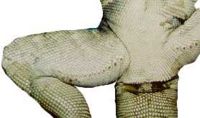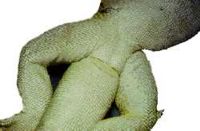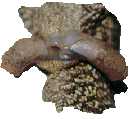| This article is still under construction. |
Male
Male lizards have paired hemipenes that are sac-like and lack erectile tissue. They are stored, inverted, in the base of the tail and may produce bulges in the ventral proximal tail. Only one is used at a time during copulation and it is not involved in urination. The testicles increase in size during the breeding season.
A row of femoral pores can be seen on the medial aspect of the thigh in many families of lizard. The waxy secretion of cellular debris produced is thought by some to have territorial scent marking significance and by others to prevent the male sliding on the belly of the female during coitus (see also preanal pore).
Mature adult male iguanas have taller dorsal spines than females, as well as larger dewlaps and operculum scales. Elaborate head ornamentation (horns, crests and plates) can be seen in adult male chameleons but not in females. Generally, for most lizard species, males are larger than their female counterparts or have larger heads, bigger crests, brighter colours, or erectable dewlaps.
Female
Females have paired ovaries and oviducts, which enter into the urodeum of the cloaca. The oviduct is divided into four regions: infundibulum; magnus (secretes albumin); uterus (secretes membrane); and vagina. Dystocia is common and may be pre-ovulatory or post-ovulatory. Fertilization is internal.
Sexing
Gender identification in juvenile animals may be challenging; however, most lizard species display sexual dimorphism as adults.
- The most reliable method of determining gender is usually by comparing pore sizes. Indeed, adult male lizards tend to have large femoral and precloacal pores on the ventral aspect of the thighs; on the other hand, adult females have smaller, more discrete pores, similar to those seen in juvenile male lizards.
- Sexing probes can also be used in iguanas and monitors but aren't as consistently accurate as they are in snakes.
- Injecting saline solution into the base of the tail in order to evert the hemipenis is another technique. However, care must be taken to avoid trauma to the hemipenis and prevent pressure necrosis. This method can be useful for species that are difficult to sex such as monitors, Tegus, large skinks, Beaded Lizards and Gila Monsters.
- Temporary eversion of the hemipenes in anaesthetized males can be done by applying gentle pressure at the base of the tail, just caudal to the cloaca.
- In some species, such as iguanas, the hemipenes in mature males will calcify and appear visible on radiographs.
- Endoscopy can be used to visualize gonads.
- Ultrasonic evaluation of the gonads or hemipenes is also possible.
References
- Zug, George R.; Vitt, Laurie J. (2001). Herpetology : an introductory biology of amphibians and reptiles. Academic Press. pp. 630. ISBN 012782622X


